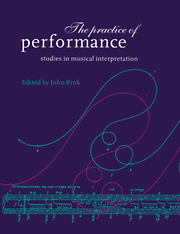Book contents
- Frontmatter
- Contents
- Preface
- PART ONE FUNDAMENTALS
- PART TWO STRUCTURE AND MEANING IN PERFORMANCE
- 5 The conductor and the theorist: Furtwängler, Schenker and the first movement of Beethoven's Ninth Symphony
- 6 A curious moment in Schumann's Fourth Symphony: structure as the fusion of affect and intuition
- 7 Beginning–ending ambiguity: consequences of performance choices
- 8 Strategies of irony in Prokofiev's Violin Sonata in F minor Op. 80
- PART THREE PERFORMANCE AS PROCESS
- Index
6 - A curious moment in Schumann's Fourth Symphony: structure as the fusion of affect and intuition
Published online by Cambridge University Press: 10 October 2009
- Frontmatter
- Contents
- Preface
- PART ONE FUNDAMENTALS
- PART TWO STRUCTURE AND MEANING IN PERFORMANCE
- 5 The conductor and the theorist: Furtwängler, Schenker and the first movement of Beethoven's Ninth Symphony
- 6 A curious moment in Schumann's Fourth Symphony: structure as the fusion of affect and intuition
- 7 Beginning–ending ambiguity: consequences of performance choices
- 8 Strategies of irony in Prokofiev's Violin Sonata in F minor Op. 80
- PART THREE PERFORMANCE AS PROCESS
- Index
Summary
How musicians conceptualise music, particularly in preparing it for performance, is a murky issue, despite the copious discussion and research that have been devoted to the matter. Ultimately, it would seem, musical concepts are a synthesis of structure and intuition – of rational views of organisation and construct; of felt entities; of an affective sense of the rightness of these perceptions.
The rational/structural is the easiest of these perspectives to deal with, which may in part explain why analytical studies in our century, influenced as that century has been by the positivistic aspect of scientific research, have gravitated towards the musical version of structuralism. Structure can be seen, heard, demonstrated. It is tangible and specific.
Intuition, of which affect is a major component, is by contrast ‘messy’. Like structure, it is experienced – perceived, specific, tangible (felt). Unlike structure, it is difficult to communicate through words and discourse – the major means by which human beings exchange ideas and concepts. As Langer has pointed out (1948, 1953, 1967), language and rational discourse are not the currency of affective communication. The materials of the modes are not only different, but essentially incompatible.
As a consequence, in our time at least, we have tended to eschew the issue. Not dealing with affect is more comfortable than dealing with it inadequately. We deal thereby with but half an artistic loaf, however; what we ignore is critical to the artistic process. Lying behind all judgements which pertain to performance, to the shaping of artistic concepts, are criteria of ‘rightness’ whose roots are intuitive, essentially affective – seemingly, though not definitively, beyond the grasp of discourse and reason.
- Type
- Chapter
- Information
- The Practice of PerformanceStudies in Musical Interpretation, pp. 126 - 149Publisher: Cambridge University PressPrint publication year: 1995



